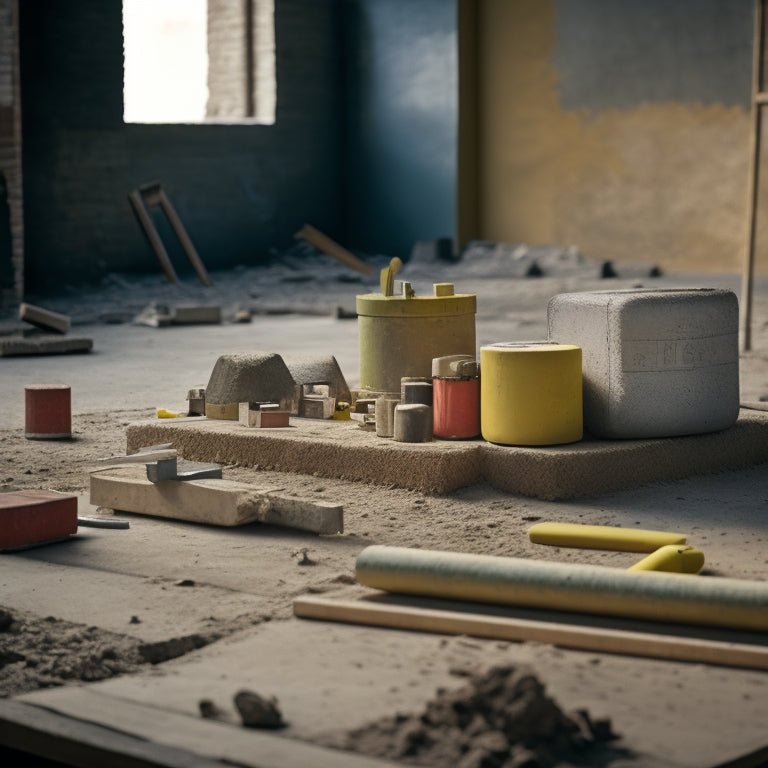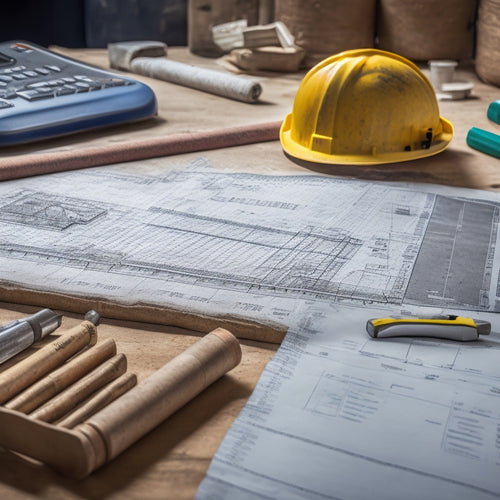
Top Tools for Leveling Concrete Block Walls
Share
When leveling concrete block walls, you'll need a range of specialized tools to guarantee accuracy and precision. Start with essential leveling equipment like precision levels, string lines, and profile gauges to detect deviations and establish a reference point. Next, employ precision alignment tools like digital inclinometers and laser alignment tools to verify vertical and horizontal alignment. Then, use block planes and scrapers to shave off excess material and remove old mortar. Finally, utilize levels and straightedges to detect slight deviations, and finishing tools like steel trowels and putty knives to smooth out the surface. Now, explore the details of each tool to master the art of leveling concrete block walls.
Key Takeaways
• Precision leveling equipment, such as precision levels and string lines, ensures walls are perfectly horizontal and vertical for stability.
• Digital inclinometers, high-precision straightedges, and laser alignment tools provide accurate measurements for vertical and horizontal verification.
• Block planes and scrapers are essential for shaving off excess material and removing old mortar and debris for refined surfaces.
• Levels and straightedges, including bubble levels and laser levels, detect and correct slight deviations from plumb and level for professional results.
• Finishing and smoothening tools, such as steel trowels and finishing trowels, help create uniform surfaces and a professional-looking finish.
Essential Leveling Equipment
You'll need three important tools to secure accurate leveling of your concrete block walls: a precision level, a string line, and a profile gauge. These essential pieces of equipment will confirm that your walls are perfectly horizontal and vertical, which is essential for foundation stabilization and overall structural integrity.
A precision level, such as a laser level, provides highly accurate readings, allowing you to detect even the slightest deviations from level. The string line helps you establish a reference point for leveling, while the profile gauge enables you to check the wall's profile and identify any deviations.
With these tools, you'll be able to achieve precise laser leveling, which is fundamental for confirming that your concrete block walls are properly aligned and stable. By using these essential tools, you'll be able to secure accurate leveling, which is significant for preventing costly mistakes and confirming the long-term stability of your structure.
Precision Alignment Tools
A precision alignment tool kit, featuring a digital inclinometer and a high-precision straightedge, enables you to fine-tune your concrete block wall's alignment with unparalleled accuracy. These tools allow you to detect even the slightest deviations from the desired angle, guaranteeing that your wall is perfectly level and plumb.
| Tool | Description |
|---|---|
| Digital Inclinometer | Measures angles with high precision, ideal for guaranteeing walls are perfectly vertical or horizontal |
| High-Precision Straightedge | Provides a precise reference point for checking the wall's alignment |
| Laser Alignment Tool | Projects a level line or point, enabling you to align blocks with ease |
| Digital Levels | Verifies the wall's levelness and plumbness, guaranteeing accuracy and precision |
| Precision Angle Measurer | Calculates angles with high accuracy, perfect for complex wall layouts |
With these precision alignment tools, you'll be able to achieve professional-grade results, even on the most demanding projects. By incorporating laser alignment, digital levels, and other precision tools into your workflow, you'll guarantee that your concrete block walls are built to last, with precision and accuracy that meets the highest standards.
Block Plane and Scrapers
Block plane and scrapers are essential tools for refining and finishing concrete block walls, allowing you to remove excess mortar, smooth out rough surfaces, and achieve a uniform finish.
When using a block plane, you'll employ various techniques to effectively shave off excess material. For instance, you'll use a pushing motion to plane the surface, keeping the tool at a consistent angle to avoid creating unevenness. As you work, regularly inspect the plane's blade and hone it as needed to maintain its efficiency.
Scrapers, on the other hand, are designed for more aggressive material removal. They're particularly useful for breaking up and removing old mortar or debris from the wall's surface.
To guarantee peak performance, prioritize scraper maintenance by regularly cleaning and storing them properly. This will prevent rust and corrosion, extending the tool's lifespan.
Levels and Straightedges
Two essential tools for guaranteeing accuracy and precision during the leveling process are levels and straightedges, which help you detect and correct even the slightest deviations from plumb and level.
As you work on leveling concrete block walls, you'll rely on these tools to confirm straight lines and perfectly horizontal surfaces.
Bubble levels, in particular, are great for checking small areas, such as individual blocks or courses, to ascertain they're level and plumb.
For larger areas, laser levels are a game-changer, projecting a precise level line across the entire surface. This allows you to quickly identify any deviations and make adjustments accordingly.
Straightedges, on the other hand, are perfect for checking the alignment of blocks and courses, verifying they're perfectly straight and level.
By combining these tools, you'll be able to achieve professional-grade results, even on complex projects.
Finishing and Smoothening Tools
You'll need a range of finishing and smoothening tools to refine the surface of your concrete block wall, ensuring a uniform texture and appearance.
As you work on surface preparation, you'll rely on these tools to remove imperfections and achieve a smooth finish. A steel trowel is essential for applying and smoothing out render or plaster, while a putty knife helps to fill in small gaps and holes. Mastering trowel techniques is vital for an even application and to prevent air pockets from forming.
For a higher level of smoothness, you may need to use a darby or a float. These tools help to remove excess material and create a uniform surface. A finishing trowel with a rubber or foam blade is perfect for the final stages of smoothening, leaving your wall with a professional-looking finish.
Remember to always work in small sections, using long, even strokes to achieve the best results. By investing in the right finishing and smoothening tools and honing your skills, you'll be able to create a concrete block wall that's both functional and visually appealing.
Frequently Asked Questions
What Is the Ideal Temperature for Leveling Concrete Block Walls?
When you're preparing to level concrete block walls, you need to take into account the ideal temperature for best curing.
Temperature effects play an essential role in the process. You'll want to work within a range of 50°F to 90°F (10°C to 32°C), with an ideal temperature between 70°F to 80°F (21°C to 27°C). This allows for proper bonding and strength development.
Avoid extreme temperatures, as they can negatively impact the curing process and compromise the wall's structural integrity.
How Often Should I Clean My Leveling Tools for Optimal Performance?
You're about to find out the secret to extending the life of your trusty leveling tools. The answer lies in cleaning frequency - the more, the merrier!
You should clean your tools after every use, and perform a deep clean every week or two, depending on usage. Proper tool maintenance is essential for ideal performance and accuracy.
Don't let dirt and grime build up, or you'll be facing a world of leveling woes. Stay on top of cleaning, and your tools will stay on top of their game.
Can I Use a Spirit Level for Leveling Concrete Block Walls?
When you're working on a concrete block wall, you'll need to guarantee precise block wall alignment.
While you can use a spirit level, it's not the most effective tool for this task. Spirit level techniques are better suited for smaller, more delicate projects.
For concrete block walls, you'll want a more robust leveling system to achieve accurate results.
Consider investing in a high-quality laser level or a specialized concrete leveling tool for peak performance.
What Safety Gear Is Recommended When Working With Leveling Tools?
When working with leveling tools, you'll want to prioritize safety.
You're dealing with heavy equipment, debris, and potential hazards, so don't skip out on essential gear.
You should always wear safety glasses to protect your eyes from flying particles and dust.
Additionally, consider donning dust masks to prevent inhalation of harmful particles.
Can I Level Concrete Block Walls During the Winter Season?
You think winter is the perfect time to cozy up with a warm cup of coffee, not to venture out and level concrete block walls? Think again!
While it's not ideal, you can level concrete block walls during the winter season. However, you'll need to adapt your winter concrete techniques to guarantee the freezing temperatures don't impact the adhesive properties of your materials.
Just remember to follow specialized winter-based application guidelines to avoid compromising the structural integrity of your walls.
Conclusion
As you complete the meticulous task of leveling concrete block walls, you're left with a sense of pride and accomplishment.
Yet, the rough, rugged surface you've tamed stands in stark contrast to the precision and finesse required to get there.
The right tools, from essential leveling equipment to finishing and smoothening tools, have been your trusted allies in this battle for perfection.
Related Posts
-

Essential Tools for Painting Concrete Walls
When painting concrete walls, you'll need a range of specialized tools to achieve a professional-looking finish. Star...
-

Top Tools for Concrete Repair Success
When it comes to concrete repair success, you'll need a well-stocked toolkit with essential hand tools like trowels, ...
-

5 Tips for Accurate Concrete Measurement Tools
To guarantee accurate concrete measurement, you'll want to calibrate your measuring tools regularly, choosing a frequ...


